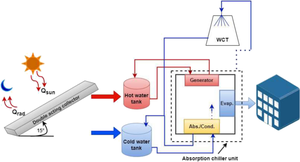Solar cooling systems are considered as an alternative to conventional mechanical compression air conditioning systems. The use of these solar cooling systems contributes to the achievement of climate change objectives. This article provides a study of a single-effect LiBr/H2O absorption cooling system with a wet cooling tower driven by a combined double-acting collector for daytime solar heating and nighttime radiative cooling for efficient use of this system in hot climate regions such as Mali. The operation of a type of double-acting collector and cooling tower was studied throughout the year. The solar energy absorbed by the double-acting collector on the first day of operation heats the water in the storage tank 1 to 80 °C after 6 to 7 h of operation, and on subsequent days this duration is reduced by 3 to 4 h depending on the weather conditions. The operating time of the solar absorption cooling system studied is on average 8 h per day for the whole year. The water in the cold-water tank, cooled by night radiation into space, ensures operation without turning on the cooling tower for an average of 73 min per day. The annual water saving for the water losses in the cooling tower due to the night operation of the combined double-acting collector is estimated at approximately 35 m3. The yearly operation of the wet cooling tower of this absorption cooling system powered by a double-acting combined collector makes it possible to save approximately 15.4% of water losses and approximately 15.2% of energy thanks to the nocturnal radiative cooling of the water by the combined collector.



